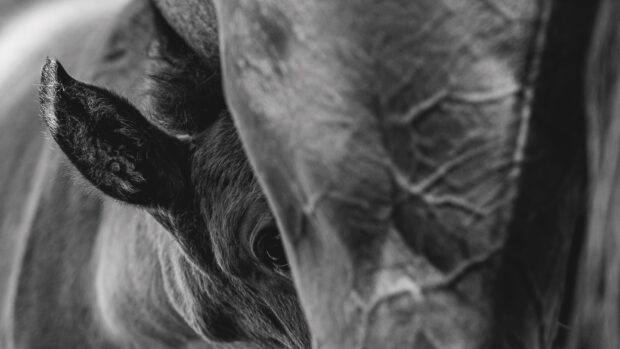Breeders are being left on average £33,000 out of pocket to get a horse through his first year of life, leading to concerns for the future of the sport.
The Thoroughbred Breeders’ Association (TBA) has raised serious concerns over the “long-term decline” of the profitability of the British thoroughbred breeding industry and the huge impact losses are having on small breeders, following a new economic impact study.
It warned that if the industry is not sustainable, there is “no future for our sport”.
The report, commissioned by the TBA and carried out by PricewaterhouseCoopers, is the third produced since 2014 and uses the same metrics so direct comparisons can be made.
“We all see the headline numbers with, £1m, £2m, £3m yearlings, but what we don’t take into account [when we read those headlines] is that there is an extremely long tail in respect of British-based sales,” said TBA deputy chairman Philip Newton.
The study shows that the median profit for yearlings is around -£33,000 and for foals approximately -£27,000.
“It is really concerning, because how sustainable can this be in the long term?” Mr Newton added.
“We have to find a way to make the returns better and ensure more breeders can make some sort of commercial return.”
The last economic impact study, released five years ago, found that in 2017, 66% of breeding operators surveyed were unprofitable. It added that the number operating at a loss had risen significantly, contributing to a decline in the number of small breeders; those with one or two broodmares.
The latest study echoed those findings of unprofitability, but this time with a more urgent warning.
“The majority of breeders operate at a loss, and that average loss made per GB sale has risen consistently since 2014,” stated the 2023 report. “Unfortunately, on its current trajectory, it is likely that these losses will worsen, leading to operators leaving the industry, and the number of elite thoroughbreds bred in Britain declining. On current trends, any future report will paint a significantly worse picture in terms of losses and exits.
“These trends would bring into question Britain’s status as a world leader in thoroughbred breeding.”
Since 2009, the number of British breeders with one or two broodmares has declined by 1,338, from 3,764 to 2,426.
Major concerns with recruiting and retaining staff were found to “have compounded the problems” of breeders, with the report waning staff shortages “will be an important blocker to industry growth unless solutions can be found”.
The study shows a drop in contribution to the UK economy of around £52m in four years, from £427m to £375, which is attributed, in large part, to industry profitability and payroll.
While the direct contributions are down, it remains a significant contributor to the economy, putting in around £375 million, and TBA chief executive Claire Sheppard added that the indirect impact – its contributions to its supply chain – remains strong.
TBA chairman Julian Richmond-Watson said the report “gives us the ammunition to push on”.
“We believe in owners, we believe in breeders, we believe in everybody else, but if we don’t have the horses, we don’t have an industry,” he said.
The introduction of the Great British Bonus (GBB) scheme in June 2020, which is worth up to £20,000 bonus prize money per race, matched a marked uptick in the average price of British fillies at sales.
“It’s made a huge difference,” said Mr Newton, adding that it has halved the gap between the average prices of fillies and colts. “GBB is working and making a difference everywhere: on the racecourse, in the breeding shed and in the sales room.”
He said promoting and developing the “gold” team of quality British broodmares is the key to “a real chance of a sustainable industry”, and that the TBA also wants to encourage and develop a base for the entire racing programme, nodding to the importance of diversity within the breed.
The report sets out three suggestions for moving forward. These are foal sharing, where no nomination fee is charged and sale proceeds are split 50:50, micro-shares of ownership and top slicing, where the stallion owner is paid a different amount for sale prices that exceed a certain threshold.
Ms Sheppard said: “It is of fundamental importance that as the TBA, and as an industry, we take action based on a sound and robust evidence base, and have a real depth of understanding of underlying trends across the whole industry.
“The long-term declining trend in the key indicators are an ongoing concern, but there are signs of hope for the future in the upturn in the 2022 British-born foal crop numbers and the positive impact of GBB on sales prices and owner returns.
“The report demonstrates that incentives and strategic interventions can work, we need to learn from this and set out a plan to take this forward with the support of breeders and the racing industry as part of racing’s new strategy.”
You might also be interested in:

Subscribe to Horse & Hound magazine today – and enjoy unlimited website access all year round

How much does it cost to breed a horse?

What makes a good broodmare – and does your horse have what it takes?

Getting ready for your mare to foal: useful advice for first-time breeders
Horse & Hound magazine, out every Thursday, is packed with all the latest news and reports, as well as interviews, specials, nostalgia, vet and training advice. Find how you can enjoy the magazine delivered to your door every week, plus options to upgrade your subscription to access our online service that brings you breaking news and reports as well as other benefits.




